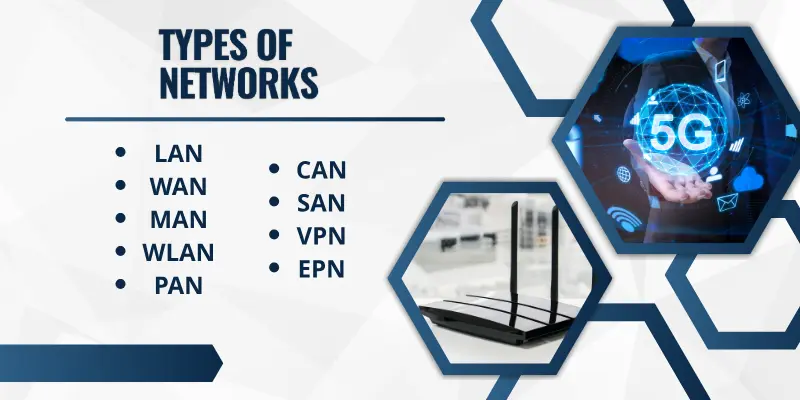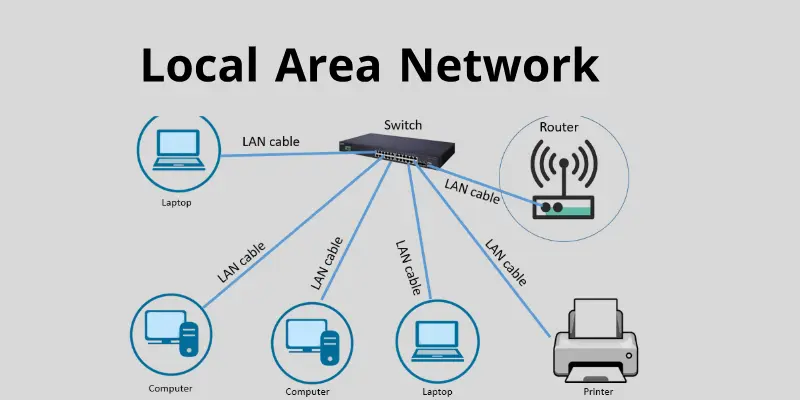Types of Networks: Simple Guide
Published: 26 May 2025
The world of computer networks is vast and complex. Different types of networks exist for various needs, such as home use, office work, and global business operations. Understanding these networks helps in choosing the right one for personal or business use.
This guide explains the main types of networks, their features, uses, and differences in simple language.
What is a Network?
A computer network is a system where multiple devices (like computers, printers, and phones) connect to share data and resources. Networks vary in size and function, relying on hardware (routers and switches) and software (network protocols) to work efficiently. Choosing the right network depends on factors like the number of devices, distance, and purpose.
Below are the main types of networks categorized by their size and usage.

1. Local Area Network (LAN)
A LAN connects devices in a small area, like a home, office, or school.
Features:
- Covers a small area (a few meters to a few kilometers).
- High-speed connection using Ethernet or Wi-Fi.
- Privately owned and controlled.
Uses:
- Sharing files and printers in an office.
- Connecting devices in a home for gaming or streaming.

Pros:
- Fast data transfer (up to 1 Gbps or more).
- Easy and cheap to set up.
Cons:
- Limited range.
- Slower performance if too many devices are connected.
2. Wide Area Network (WAN)
A WAN connects multiple LANs over large distances, such as between cities or countries.
Features:
- Covers long distances (hundreds to thousands of kilometers).
- Uses telecommunication lines, satellites, or the Internet.
- Slower speeds than LANs due to infrastructure limits.
Uses:
- Connecting the branch offices of a company.
- Providing Internet access worldwide.
Pros:
- Enables long-distance communication.
- Supports global businesses and services.
Cons:
- High cost of setup and maintenance.
- Slower speeds and security risks.

3. Metropolitan Area Network (MAN)
A MAN covers a city or large campus, bridging the gap between LANs and WANs.
Features:
- Larger than a LAN but smaller than a WAN (5-50 km).
- Often owned by local governments or large organizations.
- Uses fiber optics or wireless technologies.
Uses:
- Connecting office buildings within a city.
- Providing broadband Internet across a metro area.
Pros:
- High-speed connectivity.
- Cheaper than a WAN.
Cons:
- Limited coverage outside the city.
- Complex to manage.
4. Wireless Local Area Network (WLAN)
A WLAN is a LAN that connects devices using Wi-Fi instead of cables.
Features:
- Covers a small area like a home or office.
- Uses radio waves for communication.
- Common standards include Wi-Fi 6 and Wi-Fi 7.
Uses:
- Providing Wi-Fi access in homes, offices, or public places.
Pros:
- Easy installation (no cables needed).
- Supports mobile devices.
Cons:
- Slower than wired LANs.
- Prone to security risks.
5. Personal Area Network (PAN)
A PAN connects devices within a person’s immediate area (up to 10 meters).
Features:
- Smallest type of network.
- Uses Bluetooth, USB, or infrared technology.

Uses:
- Syncing a phone with a laptop.
- Connecting wireless accessories (earphones, keyboards).
Pros:
- Low cost and low power use.
- Simple to set up.
Cons:
- Limited range.
- Slower speeds.
6. Campus Area Network (CAN)
A CAN connects multiple LANs within a university, business campus, or military base.
Features:
- Larger than a LAN, smaller than a MAN.
- Private network for institutions.
Uses:
- Linking university buildings.
- Connecting offices in a corporate campus.
Pros:
- High-speed and efficient.
- Centralized management.
Cons:
- Limited to a specific area.
- Costly setup.
7. Storage Area Network (SAN)
A SAN is a specialized network that connects storage devices to servers.
Features:
- Designed for fast data storage and retrieval.
- Uses fiber optics or iSCSI protocols.
Uses:
- Managing enterprise data storage.
- Supporting cloud computing and virtualization.
Pros:
- High-speed and reliable storage access.
- Scalable for large businesses.
Cons:
- Expensive and complex to set up.
8. Virtual Private Network (VPN)
A VPN provides a secure, encrypted connection over a public network like the Internet.
Features:
- Operates virtually with encryption.
- Used for secure remote access.
Uses:
- Protecting data on public Wi-Fi.
- Allowing remote workers to access company networks.
Pros:
- Increased security and privacy.
- Accessible from anywhere.
Cons:
- It may slow down Internet speeds.
9. Enterprise Private Network (EPN)
An EPN is a private network built for an organization to connect its various locations.
Features:
- Custom-built for businesses.
- Can include LANs, WANs, or both.
Uses:
- Connecting multiple offices securely.
- Managing business data across regions.
Pros:
- Secure and reliable.
- Optimized for business needs.
Cons:
- High cost.
Why Understanding Networks is Important
Choosing the right network affects speed, cost, and security. For example:
- A home user needs a LAN or WLAN.
- A global company requires WANs and VPNs.
- A data-heavy industry benefits from SANs.
This guide simplifies networking concepts while including useful keywords for better online ranking. As technology evolves (5G, cloud networking, etc.), understanding these basics helps users make informed decisions in the digital world.
Conclusion
Understanding different types of networks is essential for choosing the right one for personal or business use. From small-scale LANs to global WANs, each network type serves a specific purpose. With the rise of new technologies like 5G and cloud computing, staying informed about networking basics helps individuals and businesses stay connected efficiently.
Which type of network do you use the most? Share your experiences or ask your questions in the comments below!
FAQs
Following are some important FAQs related to network types:
LAN (Local Area Network) is the most widely used network for homes and offices.
WLAN uses Wi-Fi for wireless connections, while LAN typically uses cables.
SAN (Storage Area Network) provides the fastest data transfer speeds.
It provides secure and encrypted remote access over the Internet.
It connects networks over long distances, enabling global communication.
A MAN covers a city, while a WAN covers multiple cities or countries.
A CAN is useful for larger areas like universities, while a LAN is better for small offices.
A PAN (Personal Area Network) connects devices within 10 meters.
Large businesses benefit from EPNs for secure internal communication.
SANs store and manage vast amounts of data for cloud services.

- Be Respectful
- Stay Relevant
- Stay Positive
- True Feedback
- Encourage Discussion
- Avoid Spamming
- No Fake News
- Don't Copy-Paste
- No Personal Attacks

- Be Respectful
- Stay Relevant
- Stay Positive
- True Feedback
- Encourage Discussion
- Avoid Spamming
- No Fake News
- Don't Copy-Paste
- No Personal Attacks





